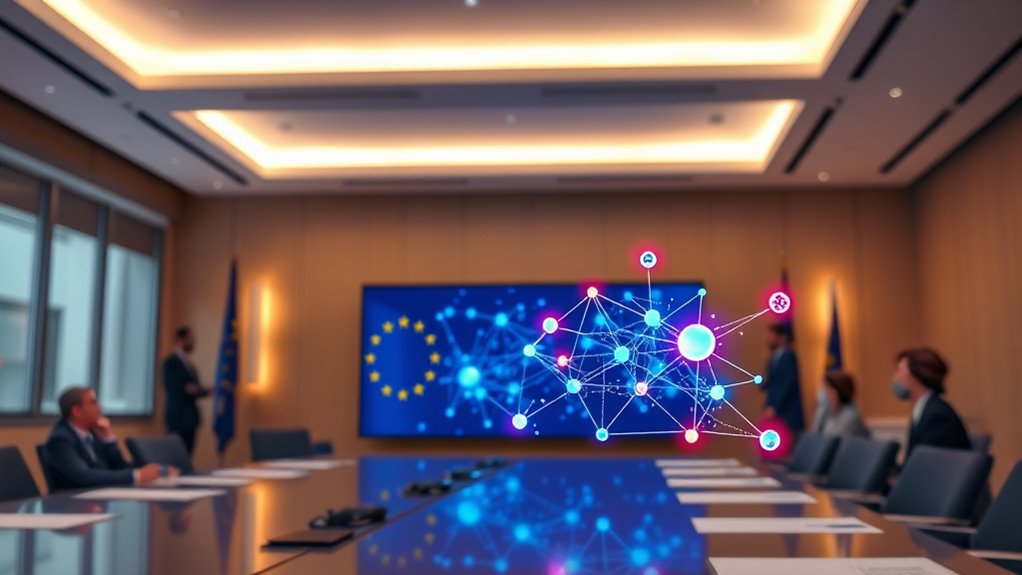The EU’s MiCA 2.0 proposal aims to extend regulations to cover DeFi platforms and NFTs, bringing greater transparency, security, and consumer protection to the digital asset market. You’ll need to be aware of new compliance requirements if you develop, operate, or use these assets, as rules will guarantee accountability and reduce fraud. By understanding these changes, you’ll better grasp how the regulatory landscape is evolving—just continue to explore to learn more.
Key Takeaways
- MiCA 2.0 extends EU regulations to cover DeFi platforms, requiring governance and transparency measures for compliance.
- The proposal mandates NFTs involved in investments or financial transactions to meet transparency and authenticity standards.
- DeFi projects will face new regulatory obligations, balancing decentralization with oversight to build trust.
- Stakeholders must adapt to increased compliance costs and operational adjustments under the new framework.
- The regulation aims to enhance market safety, transparency, and legal clarity for digital assets across the EU.

Are the European Union’s plans for MiCA 2.0 set to reshape the cryptocurrency landscape? This new proposal aims to extend regulatory frameworks to cover decentralized finance (DeFi) platforms and non-fungible tokens (NFTs), areas that have so far operated with minimal oversight. As a participant or stakeholder in this evolving space, you’ll want to understand how these changes could impact your involvement. MiCA 2.0 emphasizes the importance of digital asset compliance, ensuring that all crypto activities adhere to standards that promote transparency, security, and consumer protection. This shift aims to bring greater legitimacy and stability to the market, encouraging wider adoption and reducing risks associated with unregulated digital assets.
One of the key elements of the proposed regulation is its focus on decentralized governance. DeFi projects, known for their community-driven decision-making and lack of centralized control, will no longer be outside the regulatory perimeter. The EU plans to establish clear rules that require DeFi platforms to implement governance models aligned with compliance standards. This means that even decentralized ecosystems will need to establish transparency and accountability mechanisms, making it easier for regulators to oversee activities without undermining the core principles of decentralization. For you, this could translate into more trust in DeFi services, but also a need to verify that platforms you use are adhering to these new rules.
Decentralized DeFi platforms must now implement compliance and transparency, balancing community governance with regulatory oversight.
The regulation also addresses the challenge of regulating NFTs, which have exploded in popularity but often lack a clear legal framework. MiCA 2.0 proposes that NFTs, especially those used for investment or representing digital assets with financial value, should meet specific compliance standards. This could involve disclosures about ownership rights, authenticity, and provenance, giving you more confidence when buying or selling NFTs. Additionally, the rules aim to prevent market manipulation and fraud, protecting consumers and investors from potential abuses. Recognizing that technological advancements in project design can influence color fidelity and visual presentation, the regulation may also set standards for digital asset quality and transparency.
While these measures could bring more legitimacy to the crypto sector, they also introduce compliance obligations for developers, platforms, and users alike. You might find that certain services will need to adjust their operations to meet new standards, potentially impacting costs or innovation speeds. However, the overarching goal is to create a balanced environment where innovation can thrive alongside robust consumer protections. Overall, MiCA 2.0 is poised to reshape the regulations surrounding digital assets, making the crypto space safer and more transparent, but it also means adapting to a more regulated landscape that prioritizes compliance and governance, even within decentralized ecosystems.
Frequently Asked Questions
How Will Mica 2.0 Impact Defi Startups Financially?
MiCA 2.0 will impact your DeFi startup financially by introducing strict token licensing requirements, which could increase your initial costs. You’ll need to meet higher capital requirements to guarantee compliance, potentially straining your resources. While these regulations aim to create a safer environment, they might also limit your flexibility and growth options, making it more challenging to innovate and compete within the European market.
What Is the Timeline for Mica 2.0 Implementation?
Like a ship setting sail at dawn, the implementation timeline for MiCA 2.0 remains uncertain. Regulatory milestones are expected to unfold over the next 12 to 24 months, with draft regulations possibly coming within the next year. You should stay alert for official announcements, as the timeline could shift based on legislative progress and industry feedback. Prepare for gradual changes that will shape your DeFi ventures in the EU.
Will NFTS Be Classified as Financial Instruments Under Mica 2.0?
Under MiCA 2.0, NFTs will likely be classified as financial instruments if they meet specific criteria, which could impact how you handle NFT transactions and licensing. The regulation aims to clarify NFT classification and establish clear rules for DeFi licensing, so you’ll need to stay informed about these changes. This means you might face new compliance requirements, especially if your NFTs are considered securities or other regulated financial assets.
How Does Mica 2.0 Compare to US Crypto Regulations?
You’ll find that MiCA 2.0 emphasizes stricter regulation for cryptocurrencies, similar to US securities classification, which can impact your cryptocurrency tax obligations. Unlike US regulations, MiCA 2.0 aims to create a unified European framework, but it still considers some tokens as securities, influencing how you report and pay taxes. While US rules focus on securities and income, MiCA 2.0 targets holistic DeFi and NFT oversight.
What Are the Penalties for Non-Compliance With Mica 2.0?
If you don’t comply with MiCA 2.0, you face regulatory sanctions like hefty fines and possible suspension of your operations. Non-compliance increases compliance costs as you’ll need to implement stricter controls and reporting measures. The EU aims to enforce accountability, so ignoring these rules could severely damage your reputation and financial standing. Staying compliant minimizes these risks and helps you avoid costly penalties and legal issues.
Conclusion
So, even if you’re worried about increased regulation, remember that MiCA 2.0 aims to protect investors and foster innovation. Embracing these rules doesn’t mean stifling your opportunities; it creates a safer, more trustworthy environment for everyone. By complying now, you position yourself ahead of the curve, ready to thrive as the market matures. Instead of fearing change, see it as a chance to build a more secure future in DeFi and NFTs.








